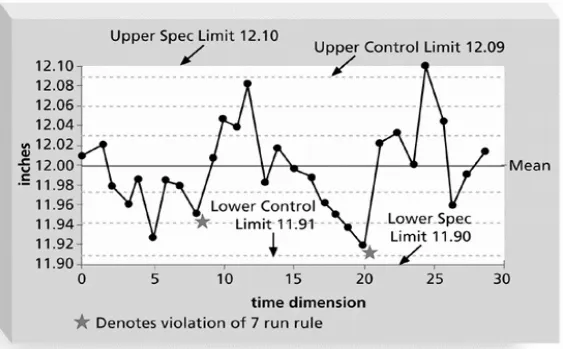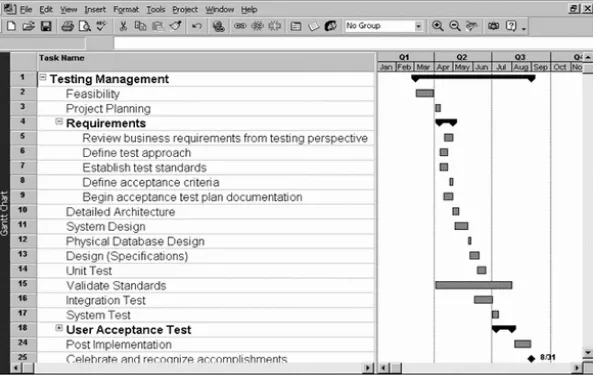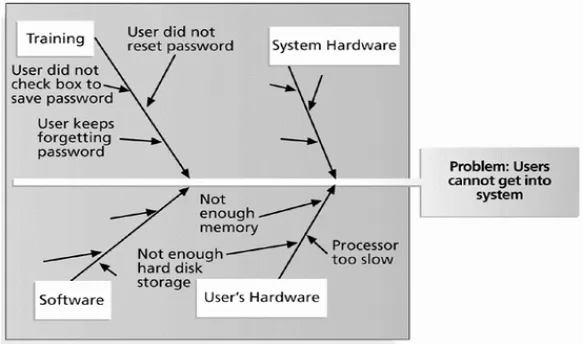What Is Quality?
• The International Organization for Standardization (ISO) defines quality as “the degree to which a set of inherent characteristics fulfils requirements” (ISO9000:2000).
• Other experts define quality based on:
– Conformance to requirements: The project’s processes and products meet written specifications.
What Is Project Quality
Management?
• Project quality management ensures that the project will satisfy the needs for which it was undertaken.
• Processes include:
– Quality planning: Identifying which quality standards are relevant to the project and how to satisfy them.
– Quality assurance: Periodically evaluating overall project performance to ensure the project will satisfy the relevant quality standards.
Quality Planning
• Implies the ability to anticipate situations and prepare actions to bring about the desired outcome.
• Important to prevent defects by:
– Selecting proper materials.
– Training and indoctrinating people in quality.
Design of Experiments
• Design of experiments is a quality planning technique that helps identify which variables have the most
influence on the overall outcome of a process.
• Also applies to project management issues, such as cost and schedule trade-offs.
Who’s Responsible for the Quality
of Projects?
• Project managers are ultimately responsible for quality management on their projects.
• Several organizations and references can help project managers and their teams understand quality.
– International Organization for Standardization (www.iso.org)
Quality Assurance
• Quality assurance includes all the activities related to satisfying the relevant quality standards for a project.
• Another goal of quality assurance is continuous quality improvement.
• Benchmarking generates ideas for quality improvements by
comparing specific project practices or product characteristics to those of other projects or products within or outside the
performing organization.
• A quality audit is a structured review of specific quality
Table 8-1. Table of Contents for a
Quality Assurance Plan*
*U.S. Department of Energy
1.0 Draft Quality Assurance Plan 1.1 Introduction 2.2 Roles and Responsibilities
2.2.1 Technical Monitor/Senior Management
2.2.2 Task Leader
2.2.3 Quality Assurance Team 2.2.4 Technical Staff
3.0 Required Documentation
4.0 Quality Assurance Procedures 4.1 Walkthrough Procedure
5.0 Problem Reporting Procedures 5.1 Noncompliance Reporting Procedures
6.0 Quality Assurance Metrics Appendix
Quality Control
• The main outputs of quality control are:
– Acceptance decisions – Rework
– Process adjustments
• Some tools and techniques include:
– Pareto analysis
– Statistical sampling – Six Sigma
Pareto Analysis
• Pareto analysis involves identifying the vital few
contributors that account for the most quality problems in a system.
• Also called the 80-20 rule, meaning that 80 percent of problems are often due to 20 percent of the causes.
Six Sigma
• Six Sigma is “a comprehensive and flexible system for achieving, sustaining, and maximizing business success. Six Sigma is uniquely driven by close understanding of customer needs, disciplined use of facts, data, and
statistical analysis, and diligent attention to managing, improving, and reinventing business processes.”*
Basic Information on Six Sigma
• The target for perfection is the achievement of no more than 3.4 defects per million opportunities.
• The principles can apply to a wide variety of processes.
DMAIC
• DMAIC is a systematic, closed-loop process for continued improvement that is scientific and fact based.
• DMAIC stands for:
– Define: Define the problem/opportunity, process, and customer requirements.
– Measure: Define measures, then collect, compile, and display data. – Analyze: Scrutinize process details to find improvement opportunities. – Improve: Generate solutions and ideas for improving the problem. – Control: Track and verify the stability of the improvements and the
How is Six Sigma Quality
Control Unique?
• It requires an organization-wide commitment. • Training follows the “Belt” system.
• Six Sigma organizations have the ability and willingness to adopt contrary objectives, such as reducing errors and
getting things done faster.
• It is an operating philosophy that is customer focused and strives to drive out waste, raise levels of quality, and
Quality Control Charts
• A control chart is a graphic display of data that illustrates the results of a process over time.
• The main use of control charts is to prevent defects, rather than to detect or reject them.
• Quality control charts allow you to determine whether a process is in control or out of control.
– When a process is in control, any variations in the results of the process are created by random events; processes that are in control do not need to be adjusted.
Testing
• Many IT professionals think of testing as a stage that comes near the end of IT product development.
Types of Tests
• Unit testing tests each individual component (often a program) to ensure it is as defect-free as possible.
• Integration testing occurs between unit and system testing to test functionally grouped components.
• System testing tests the entire system as one entity.
• User acceptance testing is an independent test
Testing Alone Is Not Enough
• Watts S. Humphrey, a renowned expert on software quality, defines a
software defect as anything that must be changed before delivery of the program.
• Testing does not sufficiently prevent software defects because:
– The number of ways to test a complex system is huge.
– Users will continue to invent new ways to use a system that its developers never considered.
• Humphrey suggests that people rethink the software development process to provide no potential defects when you enter system
Modern Quality Management
• Modern quality management:
– Requires customer satisfaction.
– Prefers prevention to inspection.
– Recognizes management responsibility for quality.
Quality Experts
• Deming was famous for his work in rebuilding Japan and his 14 Points for Management.
• Juran wrote the Quality Control Handbook and ten steps to quality improvement.
• Crosby wrote Quality is Free and suggested that organizations strive for zero defects.
• Ishikawa developed the concepts of quality circles and fishbone diagrams.
• Taguchi developed methods for optimizing the process of engineering experimentation.
Malcolm Baldrige Award
• The Malcolm Baldrige National Quality Award originated in 1987 to recognize companies that have achieved a level of world-class competition through quality management.
• Given by the President of the United States to U.S. businesses.
• Three awards each year in different categories:
– Manufacturing – Service
– Small business
ISO Standards
• ISO 9000 is a quality system standard that:
– Is a three-part, continuous cycle of planning, controlling, and documenting quality in an organization.
– Provides minimum requirements needed for an organization to meet its quality certification standards.
– Helps organizations around the world reduce costs and improve customer satisfaction.
Leadership
• As Joseph M. Juran said in 1945, “It is most important that top management be quality-minded. In the absence of sincere manifestation of interest at the top, little will happen below.”*
• A large percentage of quality problems are associated with management, not technical issues.
The Cost of Quality
• The cost of quality is the cost of conformance plus the cost of nonconformance.
– Conformance means delivering products that meet requirements and fitness for use.
– Cost of nonconformance means taking responsibility for failures or not meeting quality expectations.
• A 2002 study reported that software bugs cost the U.S. economy $59.6 billion each year and that one third of the bugs could be eliminated by an improved testing
infrastructure.*
Expectations and Cultural
Differences in Quality
• Project managers must understand and manage stakeholder expectations.
• Expectations also vary by:
– Organization’s culture
Using Software to Assist in Project
Quality Management
• Spreadsheet and charting software helps create Pareto diagrams, fishbone diagrams, and so on.
• Statistical software packages help perform statistical analysis.
• Specialized software products help manage Six Sigma projects or create quality control charts.
• Project management software helps create Gantt charts and other tools to help plan and track work related to


